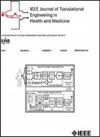Projected AR Serious Game “Painting Discovery” for Shoulder Rehabilitation: Assessment With Technicians, Physiotherapists, and Patients
IF 4.4
3区 医学
Q2 ENGINEERING, BIOMEDICAL
IEEE Journal of Translational Engineering in Health and Medicine-Jtehm
Pub Date : 2025-04-02
DOI:10.1109/JTEHM.2025.3557250
引用次数: 0
Abstract
Objective: Motivation and adherence are crucial for effective rehabilitation, yet engagement remains a challenge in upper limb physiotherapy. Serious Games (SGs) have emerged as a promising tool to enhance patient motivation. This study evaluates Painting Discovery, a projected augmented reality (AR) SG for shoulder rehabilitation, assessing engagement, ergonomics, and its potential to differentiate motor performance between healthy and those with rheumatoid arthritis, bursitis, subacromial impingement, rotator cuff tear, or calcific tendinopathy. Additionally, it examines improvements in pathological subjects following physiotherapy. Method: Sixteen healthy and seven pathological subjects participated. Engagement, ergonomics, and satisfaction were assessed using Likert-scale questionnaires. Motor performance was evaluated through completion time, speed, acceleration, and normalized jerk. Four pathological subjects underwent pre- and post-physiotherapy assessments over six weeks. Results: SG was highly engaging and ergonomic, with no significant differences based on prior video game or AR experience. The pathological group had longer completion times (用于肩部康复的投影AR严肃游戏“绘画发现”:技术人员,物理治疗师和患者的评估
目的:动机和坚持是有效康复的关键,但参与上肢物理治疗仍然是一个挑战。严肃游戏(Serious Games, SGs)已成为增强患者动机的一种有前景的工具。本研究评估了用于肩部康复的增强现实(AR) SG - Painting Discovery,评估了参与性、人体工程学及其区分健康人与类风湿关节炎、滑囊炎、肩胛下撞击、肩袖撕裂或钙化肌腱病患者运动表现的潜力。此外,它还检查了物理治疗后病理受试者的改善。方法:健康受试者16例,病理受试者7例。参与、人体工程学和满意度采用李克特量表问卷进行评估。运动性能通过完成时间、速度、加速度和标准抽动来评估。四名病理受试者在六周内接受了物理治疗前后的评估。结果:SG是高度参与和符合人体工程学,没有显著差异基于先前的视频游戏或AR经验。病理组完成时间较健康组长(56.49~ 37.85$ s vs. 39.02~ 24.21$ s, p < 0.001),加速度较低(1.11~\pm ~0.92$ m/s2 vs. 0.79~\pm ~0.56$ m/s2, p < 0.001),跳速较高(6.68\ × 107~\pm ~1.37\ × 108$ m/s3 vs. 9.22\ × 106~\pm ~2.51\ × 107$ m/s3, p = 0.025)。物理治疗后,完成时间和正常抽搐表明效率和控制力增强。结论:绘画发现显示出强大的潜力,作为一个有吸引力的,可访问的康复工具。虽然在区分运动障碍方面是有效的,但它的小样本量和水平平面运动焦点限制了更广泛的结论。未来的研究应扩大参与,纳入垂直平面运动,并完善临床验证的性能指标。
本文章由计算机程序翻译,如有差异,请以英文原文为准。
求助全文
约1分钟内获得全文
求助全文
来源期刊

IEEE Journal of Translational Engineering in Health and Medicine-Jtehm
Engineering-Biomedical Engineering
CiteScore
7.40
自引率
2.90%
发文量
65
审稿时长
27 weeks
期刊介绍:
The IEEE Journal of Translational Engineering in Health and Medicine is an open access product that bridges the engineering and clinical worlds, focusing on detailed descriptions of advanced technical solutions to a clinical need along with clinical results and healthcare relevance. The journal provides a platform for state-of-the-art technology directions in the interdisciplinary field of biomedical engineering, embracing engineering, life sciences and medicine. A unique aspect of the journal is its ability to foster a collaboration between physicians and engineers for presenting broad and compelling real world technological and engineering solutions that can be implemented in the interest of improving quality of patient care and treatment outcomes, thereby reducing costs and improving efficiency. The journal provides an active forum for clinical research and relevant state-of the-art technology for members of all the IEEE societies that have an interest in biomedical engineering as well as reaching out directly to physicians and the medical community through the American Medical Association (AMA) and other clinical societies. The scope of the journal includes, but is not limited, to topics on: Medical devices, healthcare delivery systems, global healthcare initiatives, and ICT based services; Technological relevance to healthcare cost reduction; Technology affecting healthcare management, decision-making, and policy; Advanced technical work that is applied to solving specific clinical needs.
 求助内容:
求助内容: 应助结果提醒方式:
应助结果提醒方式:


